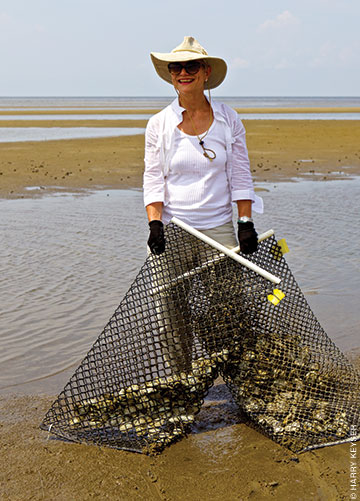
Class of ’78 | Before she became an oyster farmer, Stephanie Tramdack Cash WG’78 rarely noticed the tides. Now she’s keenly attuned to them—especially when she’s out wading in the Delaware Bay, bagging mollusks on her aquatic lease, examining each oyster for imperfections and size—and the water begins to slosh higher and higher.
“You have to get out of there!” she says. If she stays too long, her hip boots could fill with water—among other perils. Not long ago her husband, Richard, went after a lost oyster bag only to discover the tide was changing. He wasn’t sure he’d make it back, and he’s the stronger swimmer of the two.
Three years into running Dias Creek Oyster Company, Cash has found herself organizing everything around those tides.
“You have to make plans with your tide table in hand as much as your calendar,” she says. “Everyone hates it if there was a good low tide—which means several good hours to work out there—and somebody decided to schedule a meeting.”
The meetings are different, too. Sit-downs with her local oyster cooperative or the US Fish and Wildlife Service have replaced the ones she had as a land-locked financial strategist, then a language instructor, and eventually a French-to-English translator.
Cash left her desk in 2012 to start oyster farming with Richard. The couple had lived in Cape May Court House for 22 years by then, and a local friend had offered them his 100-acre aquatic lease.
“We were startled,” she remembers, “but not that startled, because we had been interested in this.”
From time to time over the years, the couple had pulled on boots, packed up sharpened screwdrivers, and headed out to pry oysters from rocks. (New Jersey sells $10 recreational shellfish licenses that let residents harvest clams, scallops, mussels, and oysters from designated areas.)
“We felt like it would be a crime not to use this resource,” Cash says of the hand-me-down aqua-lease. She’d also noticed that new oyster bars were opening, and local shops had more and more varieties for sale. The East Coast Shellfish Growers Association estimates that there are more than 400 niche oyster brands on the East Coast alone, and that production has doubled over the last five years.
“We could see that the industry is being encouraged right now, especially by our county government,” Cash says. “It’s a boost for tourism and the greenest possible industry: oysters make the water cleaner.”
Dias Creek Oyster Company is on the New Jersey side of the Delaware Bay, about eight miles from the Atlantic. Cash says the wetlands water and ocean salt combine to make a memorable mollusk: “sweetness and truffly earthiness.” She’s dubbed them Venus oysters.
They start as seeds in the Rutgers Aquaculture Innovation Center and come to Dias Creek at a miniscule two millimeters. The Cashes put them inside bags, hang them on racks in the bay, and raise them to be plump and big—but not too big. Their oyster population ranges from about 50,000 up to 130,000 at any given time.
Cash says they’ve been selling as many oysters as they can raise and process—a few hundred a week—mostly to local restaurants and upscale seafood shops. “We can see a future of profitability on the horizon,” she adds, “though we’ve learned that the future for an oyster farm is not readily analyzable.”
She’s also immersed herself in the local oystering scene. As interim chair of the Cape May Oyster Cooperative, she works on marketing issues and farming dilemmas—and red tape.
“At least 14 agencies regulate us,” she says, noting that everyone in her co-op has had a run-in with the authorities. “There just isn’t really [specific] regulation for what we’re doing. They try to apply the rules for wild-oyster harvest to us, but that makes as much sense as regulating cattle farmers under the rules for hunting.”
She’s hopeful that a simpler system will eventually emerge. But in the meantime, it’s easy to forget about the legal hassles when she’s out in the water, with only herons and egrets and tiny black snails for company.
“Becoming an oyster farmer was never on my list of things to do in life,” she says. “And there are times I’m out there complaining loudly. But then I look around, and it’s just absolutely beautiful.”
—Molly Petrilla C’06

